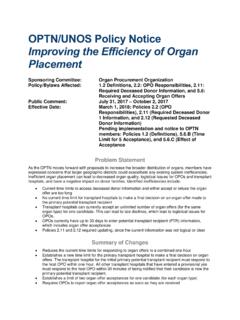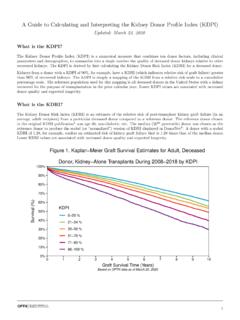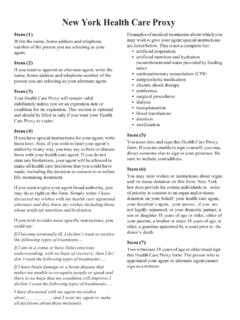Transcription of OPTN Policies effective January 11 2022 [Reinstate 1.4.F]
1 Policies Contents Policy 1: Administrative Rules and Definitions 1. Policy 2: Deceased Donor Organ Procurement 22. Policy 3: Candidate Registrations, Modifications, and Removals 36. Policy 4: Histocompatibility 46. Policy 5: Organ Offers, Acceptance, and Verification 77. Policy 6: Allocation of Hearts and Heart-Lungs 89. Policy 7: Allocation of Intestines 125. Policy 8: Allocation of Kidneys 127. Policy 9: Allocation of Livers and Liver-Intestines 156. Policy 10: Allocation of Lungs 211. Policy 11: Allocation of Pancreas, Kidney-Pancreas, and Islets 242. Policy 12: Allocation of Vascularized Composite Allografts (VCA) 251. Policy 13: Kidney Paired donation (KPD) 252. Policy 14: Living donation 269. Policy 15: Identification of Transmissible Diseases 291. Policy 16: Organ and Extra Vessel Packaging, Labeling, Shipping, and Storage 300.
2 Policy 17: International Organ Transplantation 307. Policy 18 Data Submission Requirements 310. Policy 19: Data Release 320. Policy 20: Travel Expense and Reimbursement 321. Organ Procurement and Transplantation Network (OPTN) Policies Policy 1: Administrative Rules and Definitions Rules of Construction 1. Definitions 1. Variances 17. Allocation of Organs during Emergencies 20. Department of Defense Directive 21. Rules of Construction The rules and definitions set forth in this Policy apply to all OPTN Policies . Time A day ends at midnight Eastern Standard Time (EST). Headings, Notes, and History All headings, notes, and history sections of these Policies , are intended only as guidance and to supplement the OPTN Policies and are not part of the Policies . These sections and headings are nonbinding to members and should not be treated as policy or used to infer the intent of the Policies .
3 Reporting of Information to the OPTN. Members must report requested information to the OPTN to fulfill membership requirements and to ensure compliance with OPTN Policies and Bylaws. The OPTN will determine the required method and format for reporting any information required by OPTN Policies and Bylaws, including the requirement to submit specific forms at defined times. Signature Signatures necessary to meet OPTN Obligations may be handwritten or electronically produced, including digital or electronically imaged signatures. Definitions The definitions that follow are used to define terms specific to the OPTN Policies . A. Active candidate A candidate on the waiting list who is currently suitable for transplantation and eligible to receive organ offers. Agent A person legally authorized to act on behalf of another person.
4 effective Date: 1/11/2022 Page 1. OPTN Policies Policy 1: Administrative Rules and Definitions Allocation MELD or PELD Score The highest exception or calculated MELD or PELD score available to the candidate according to Policy. Allocation MELD or PELD score includes liver-intestine points. Alternative allocation system A type of variance that allows members who are permitted to join the variance to allocate organs differently than the OPTN Policies . Alternative local unit (ALU). A type of variance that creates a distinct geographic area for organ procurement and distribution. Alternative point assignment system A type of variance that allows members who are permitted to join the variance to assign points for organ allocation differently than required by the OPTN Policies .
5 Antigen mismatch An antigen mismatch occurs when an identified deceased or living donor antigen is not recognized as equivalent to the recipient's own antigens. In cases where a donor or candidate only has one antigen identified at a human leukocyte antigen (HLA) locus (A, B, or DR), the antigens are considered to be identical at that locus. Authorization The act of granting permission for a specific act. This is sometimes called consent, which is not to be confused with informed consent. B. Backup offer An organ offer made to a lower ranked candidate on a deceased donor match run after a transplant hospital accepts an organ on behalf of a higher ranked candidate, but before the organ is transplanted. Bridge donor A Kidney Paired donation (KPD) donor who does not have a match identified during the same match run as the donor's paired candidate and continues a chain in a future match run.
6 Business days Calendar days excluding Saturdays, Sundays, and federal holidays. C. Calculated MELD or PELD Score The highest non-exception MELD or PELD score available to the candidate according to Policy. Calculated MELD or PELD score excludes liver-intestine points. effective Date: 1/22/2022 Page 2. OPTN Policies Policy 1: Administrative Rules and Definitions Calculated Panel Reactive Antibody (CPRA). The percentage of deceased donors expected to have one or more of the unacceptable antigens indicated on the waiting list for the candidate. The CPRA is derived from HLA antigen/allele group and haplotype frequencies for the different ethnic groups in proportion to their representation in the national deceased donor population. Candidate A person registered on the organ transplant waiting list.
7 When a candidate appears on the match run, the candidate is then referred to as a potential transplant recipient (PTR). Chain A set of KPD matches that begins with a donation from a non-directed living donor to that KPD donor's matched candidate. This candidate's paired living donor then donates to the KPD donor's matched candidate. A chain continues until a living donor donates to an orphan candidate, a waiting list candidate or is a bridge donor. Classification A collection of potential transplant recipients grouped by similar characteristics and within a given geographical area. Classifications are used to rank potential recipients of deceased or living donor organs. A collection of ranked classifications of potential transplant recipients is also known as an organ allocation algorithm.
8 Closed variance A variance that is not open for other members to join it. Covered Vascularized Composite Allograft body parts (covered VCAs). The body parts listed below are covered VCAs. Covered VCAs are categorized by type as follows: effective Date: 1/22/2022 Page 3. OPTN Policies Policy 1: Administrative Rules and Definitions Covered VCA(s) Type: Any group of vascularized body parts from the Upper limb upper limb Face, larynx, vascularized parathyroid gland, Head and neck scalp, trachea, vascularized thyroid, and any other vascularized body parts from the head and neck Abdominal wall, symphysis pubis, and any group Abdominal wall of vascularized skeletal elements of the pelvis Uterus, internal and external male and female Genitourinary organ genitalia, and urinary bladder Adrenal and thymus Vascularized gland Pelvic structures that are attached to the lower Lower limb limb and transplanted intact, gluteal region, vascularized bone transfers from the lower extremity, toe transfers, and any group of vascularized body parts from the lower limb Spine axis, chest wall.
9 And other composite graft Musculoskeletal composite graft segment of vascularized muscle, bone, nerve, or skin Spleen Spleen D. Day Calendar day. Deceased donor An individual from whom at least one organ is recovered for the purpose of transplantation after declaration of death. Directed donation The allocation of a deceased or living donor organ to a specific candidate named by the person who authorized the donation . Domino donor An individual who has an organ removed as a component of medical treatment and who receives a replacement organ. The organ that was removed is transplanted into another person. donation after Circulatory Death (DCD). donation after Circulatory Death (DCD) describes the organ recovery process that may occur following death by irreversible cessation of circulatory and respiratory functions.
10 A DCD donor may also be called a non-heartbeating, asystolic, or donation after cardiac death donor. effective Date: 1/22/2022 Page 4. OPTN Policies Policy 1: Administrative Rules and Definitions donation Service Area (DSA). The geographic area designated by the Centers for Medicare and Medicaid Services (CMS) that is served by one organ procurement organization (OPO), one or more transplant hospitals, and one or more donor hospitals. Donor hospital The hospital where the deceased or living donor is admitted. Donor ID. A unique identification assigned to each deceased and living donor by the OPTN. Donor record The record maintained by the OPO regarding an individual deceased donor. E. Eligible death For reporting purposes of DSA performance assessments, an eligible death for deceased organ donation is defined as the death of a patient who meets all the following characteristics: Is 75 years old or less Is legally declared dead by neurologic criteria according to state or local law Has body weight of 5 kg or greater Has a body mass index (BMI) of 50 kg/m2 or less Has at least one kidney, liver, heart or lung that is deemed to meet the eligible data definition as defined below: o The kidney would initially meet the eligible data definition unless the donor meets any of the following criteria.














